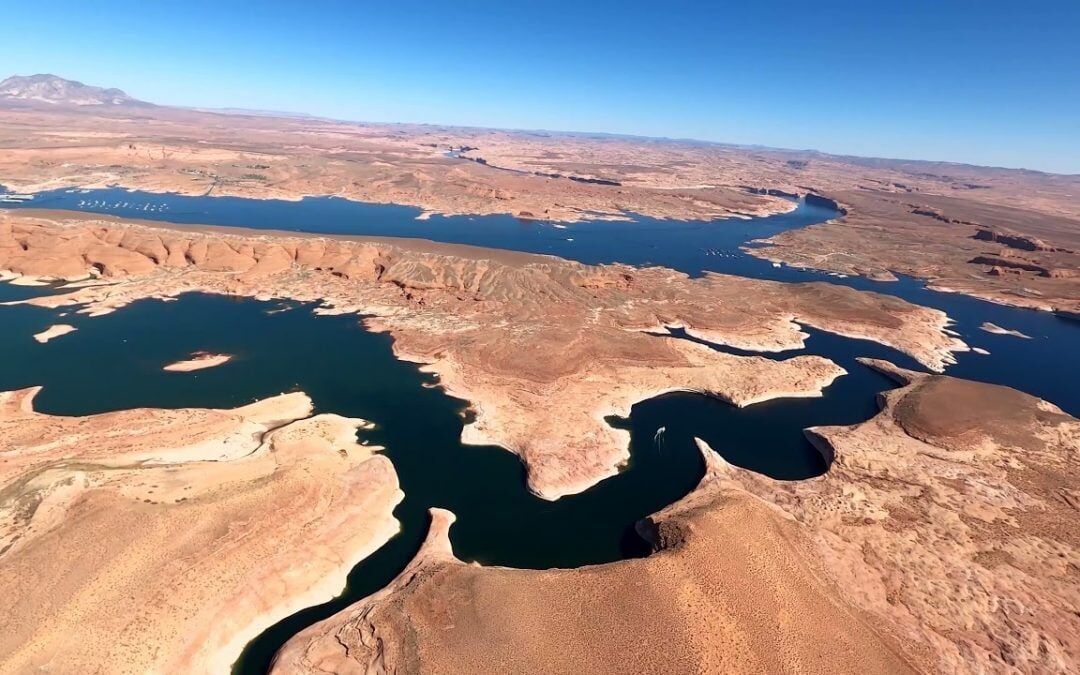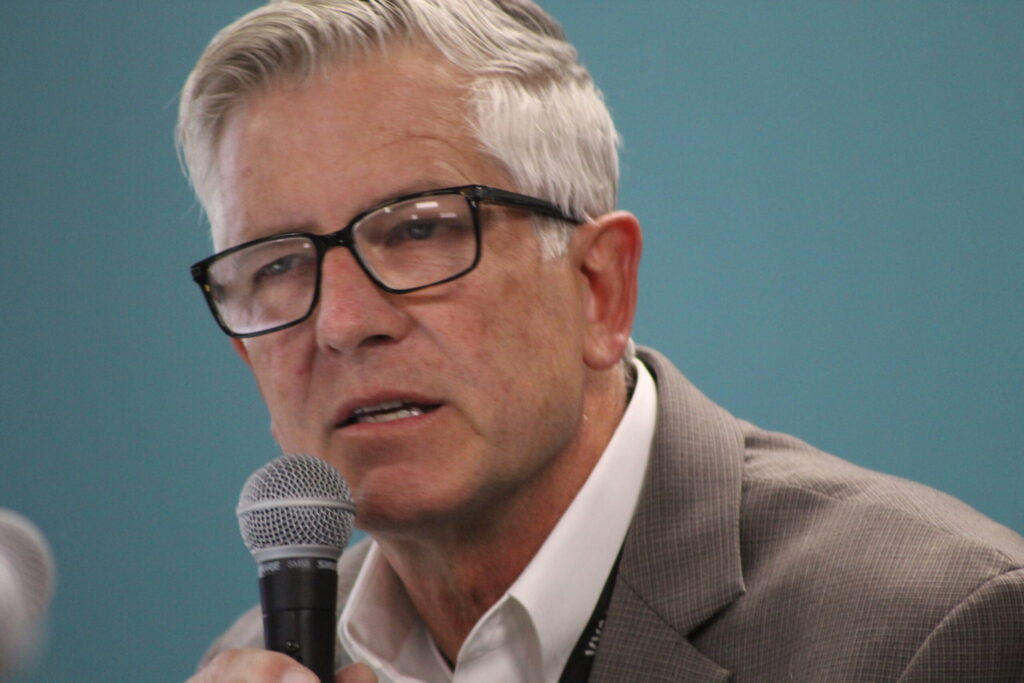Expert calls for lower basin Colorado River states to adopt percent-based allocation

An expert described as one of the best minds on water in the West believes it’s time to reconsider some of the basics of the 1922 Colorado River Compact, the cornerstone of the “Law of the River” that apportions water and regulates use.
Former Colorado River District Manager Eric Kuhn said negotiations over Colorado River operations, set to start in the coming weeks, should include changing how water is allocated to Mexico and the lower basin states of Arizona, California and Nevada.
Kuhn spoke about those ideas during the second day of the Colorado River conference sponsored by the Getches-Wilkinson Center for Natural Resources, Energy and the Environment at the CU Law School. He spoke, along with former Arizona Gov. Bruce Babbitt, who served eight years as Secretary of the Interior in the Clinton administration.
Allocations to the three lower basin states and Mexico are based on a fixed amount of acre-feet of water. An acre-foot is some 362,000 gallons. That’s enough to cover Empower Field with one foot of water, or provide for two families of four for a year.
In 1922, the lower basin states were allocated 8.5 million acre-feet (MAF), while the upper basin states of Colorado, Wyoming, Utah and New Mexico were allocated 7.5 MAF per year. That left a surplus in the river, estimated at a total of 20.5 MAF.
The river today is instead running at a deficit of 4.5 MAF per year, which also takes into account the 1.5 MAF allocated to Mexico. The 8.5 MAF available to the lower basin states in 1922 now stands at only 6 MAF now, including system evaporative and transmission losses.
The upper basin states have never used their full allocation – in most years, upper basin use stands around 4.5MAF. A 1948 compact among the upper basin states dictates those allocations on a percentage basis.
That percentage concept should be how water is allocated for the lower basin states, Kuhn said Friday. He also called for a compact for the lower basin states that incorporates other principles from the upper basin compact.
He said that compact, and what could go into it, could mean changing some of the basics of the law of the river.
Kuhn also suggested the lower basin states define consumptive use, another hallmark in the upper basin that hasn’t made its way south.
Consumptive use is the total amount of water used, for irrigation, human use or through evaporative loss. The latter is not something the lower basin states have ever considered, although Colorado River Board of California Chair JB Hamby said those losses just show up as shortages on the river, and not a part of the allocation.
Without incorporating a uniform definition of consumptive use, Kuhn said, there will be endless fights among the lower basin states on how to divvy up reductions in Colorado River water.
Babbitt expressed hesitation on whether those ideas are doable, adding he was skeptical about untangling the numerical allocations and translating them into percentages.
Kuhn didn’t disagree. Turning these fixed contracts into a percentage is going to be difficult, he said.
Babbitt focused on solutions and models that he said shows the way for successful, and most importantly, voluntary participation in water reductions. But he also had harsh words for some of the ideas currently being floated in the upper basin states and by the federal government.
Agriculture uses upwards of 75% of the water that comes down the Colorado, Babbitt said, with tribes entitled to much of the rest. With agriculture being such a driver of use, he said the question becomes how to motivate industry participation that produces results.
Farmers view some of the suggested programs as akin to “buy and dry.” That’s something of a dirty word in agriculture referring to siphoning water for other purposes and leaving behind dry, barren and often unfarmable land. Another proposed solution viewed with skeptical eyes is speculation, the purchase of water rights that are then held in abeyance as those rights increase in value. Babbitt pointed to Wall Street hedge funds. The third solution that Babbitt believes has little chance of success is the system conservation pilot program being implemented by the upper basin states, and funded by the federal government.
Babbitt said he’s heard that Colorado farmers, in particular, are suspicious of those programs.
So what does work? Babbitt had three models, including one from Colorado, which rely on voluntary participation from agriculture.
The first he pointed to is what the Palo Verde Irrigation District has been doing for 10 years in California. Farmers voluntarily engage in rotational fallowing and other programs, with a cap on the amount of water that can be transported and conserved in any given year. A farmer can only participate in the program once every three years, and there’s more demand for participation than there is available water under the cap.
Colorado’s Super Ditch in the Lower Arkansas Valley is another example Babbitt highlighted of a voluntary program with support from agriculture.
A 2017 Water Education Colorado report said that in 2008, shareholders of six ditches between Pueblo and Lamar created the Lower Arkansas Valley Super Ditch Co., growing to seven ditch companies with eight ditches.
A pilot project on the Catlin Canal put 911 acres into rotational fallowing in 2015. That allowed for some of the water to be leased to Fowler, and the Fountain and Security water district. The six participating farmers in Catlin were paid $1,030 per acre with $500 per acre-foot of water delivered.
The third program Babbitt pointed to is the Conservation Reserve Program of the US Department of Agriculture. Under that program, the federal government pays farmers an annual rental rate for up to 15 years to remove environmentally sensitive land from production.
In Colorado, state and federal officials recently inked a new agreement to enact a CREP program in the Republican River basin on the Eastern Plains. That program is intended to help retire irrigation wells in the basin in order to meet compact requirements with Kansas and Nebraska. Under the voluntary agreement, farmers would place their irrigated acres into the program in exchange for the rental payment. But they’d still be allowed to farm crops suitable for dryland farming, such as corn, wheat or sorghum.
Babbitt said the CREP program has taken out of production about 20 million acres of farmland on a voluntary basis. It’s backed by farmers and Farm Bureau organizations, and paid for with a $2 billion annual appropriation from the federal government.
The tribal issue is more complicated, in part because many of the 30 tribes in the Colorado River basin haven’t historically had a seat at the table, and the water they’re entitled to hasn’t been available. That’s been an ongoing discussion in the forums held at the conference.
The assumption, Babbitt said, is that some of the necessary and significant water reductions in the basin will have to come from the tribes. That draws pushback from tribes, in part because many of the reservations lack the basic infrastructure to even bring water onto their lands. Some of their water rights also have not been fully adjudicated, Babbitt added.
That will take involvement from the Department of the Interior as the “lead non-Indian participant” that will ensure those water rights are in place first.
Babbitt pointed to one model that has already shown promise in this area: the Gila River Indian Community in Arizona. The settlement that bumps up against the Phoenix metro has not only ensured its own water rights but has contributed to conservation efforts on the Colorado River.
That was the result of an “incredible negotiation” in which tribes and other participants worked through 135 side agreements that reflected participation of 35 different entities, almost every town, city, village and irrigation district in central Arizona, Babbitt said.
Friday’s panels also include a discussion on how agriculture can thrive with less water, the role for tribal water development in basinwide “belt-tightening,” and environmental interests.














